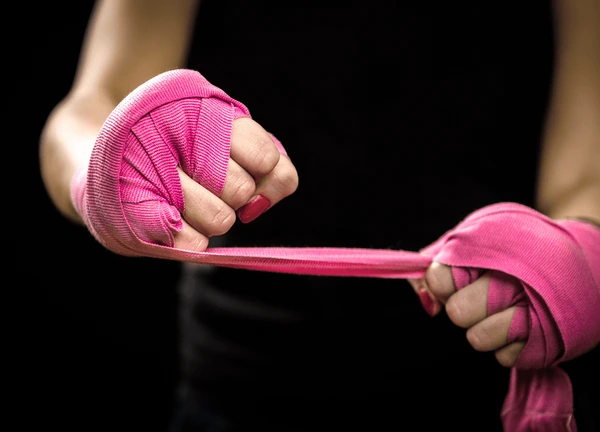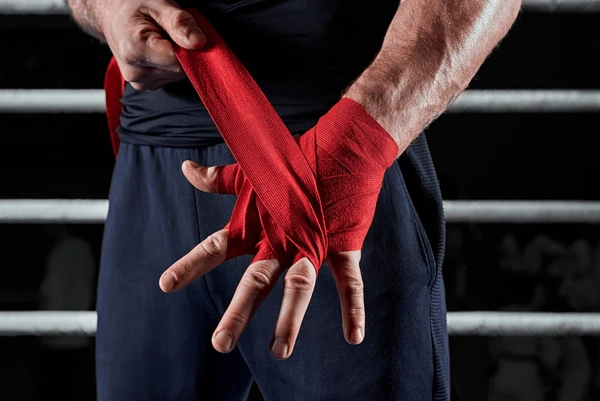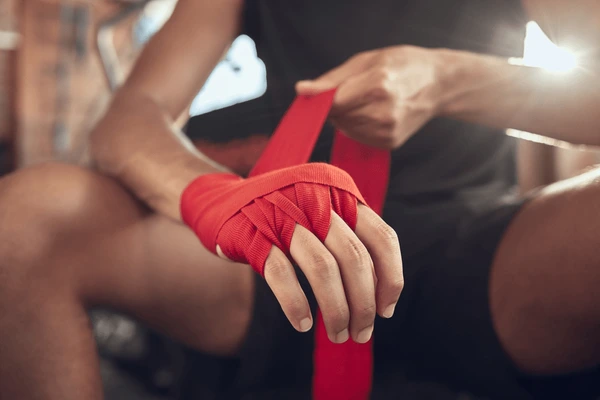Introduction to Quick Wraps and Hand Wraps
When it comes to protecting our hands during training, we’ve got two main choices: quick wraps and traditional hand wraps. Both serve the same purpose—providing support, stabilizing the wrist, and protecting the knuckles—but they’re designed with different needs in mind.
Quick wraps are pre-made, slip-on options that can save time and are super convenient for those of us juggling busy schedules. On the other hand, traditional hand wraps require a bit of effort to wrap properly but offer a customizable fit for maximum support.
Deciding between the two means understanding how they work, their pros, and whether they meet our specific needs.

Purpose of Hand Protection in Combat Sports
When we train or compete in combat sports, our hands take a significant beating. They’re our primary tools for punching, blocking, and grappling, yet they’re made up of delicate bones, tendons, and joints prone to injury. Hand protection minimizes the risk of fractures, sprains, and bruising while ensuring we maintain proper form during strikes. It also provides wrist stability, reducing stress from repeated impacts. Beyond safety, protecting our hands helps us train longer and harder without discomfort. Whether we’re beginners or seasoned fighters, safeguarding our hands is non-negotiable to maximize performance and avoid long-term damage.
|
|
Celestial Quick Wraps |
Overview of Quick Wraps: What Are They?
Quick wraps are a modern alternative to traditional hand wraps, designed for convenience and speed. Instead of spending time wrapping our hands manually, we simply slide these on like a glove. They often come with a gel-padded layer for extra protection and an adjustable Velcro strap for a secure fit.
Here’s what they offer:
-
Ease of Use: No wrapping skills required—just slip and strap.
-
Time-Saving: Ideal for those of us squeezing training into a busy schedule.
-
Extra Padding: Built-in gel cushions absorb impact effectively.
They’re lightweight, compact, and perfect for grabbing on the go, making them great for routine training or cardio-focused sessions.
|
|
Starry Night Hand Wraps |
Overview of Traditional Hand Wraps: What Are They?
Traditional hand wraps are long strips of fabric that we use to protect our hands, knuckles, and wrists during training. They provide support and stability while absorbing the impact from punches. Typically made from stretchy cotton or semi-elastic materials, they allow us to achieve a snug fit without cutting off circulation.
We wrap them around our hands in a specific pattern to cover key areas like the knuckles, thumb, and wrist. Available in various lengths—usually 120 to 180 inches—traditional wraps ensure a customizable fit. They may feel time-consuming at first, but they’re reusable and adjustable to suit your training needs.
Key Differences Between Quick Wraps and Hand Wraps
When it comes to selecting between quick wraps and traditional hand wraps, the differences really stand out depending on what we need in our training.
-
Convenience: Quick wraps save us so much time—they slip on like gloves. Hand wraps take longer, requiring us to carefully wrap them for the right fit.
-
Support: Hand wraps offer customizable wrist and knuckle support since we control the tension. Quick wraps are more fixed, providing less adjustability.
-
Padding: Most quick wraps come with built-in padding for extra knuckle protection, whereas hand wraps rely on layering.
-
Durability: Traditional hand wraps tend to last longer when properly maintained, while quick wraps may wear out faster with regular use.
Pros and Cons of Using Quick Wraps
When it comes to quick wraps, we love how convenient they are. They save so much time, especially when we're rushing to fit training into a packed schedule. Sliding them on takes just seconds, and they usually have built-in padding to protect our knuckles. Plus, they’re a breeze to clean compared to traditional hand wraps.
But let’s be real—there are trade-offs. Quick wraps don’t always offer the same level of wrist support or snug fit, which can be risky during heavy bag sessions. Over time, they also tend to wear out faster. So while they’re practical, they may not suit everyone’s training needs.
Pros and Cons of Using Hand Wraps
When it comes to hand wraps, we’ve got a lot to unpack. Here's the breakdown:
Pros
-
Custom Fit: We can wrap our hands exactly how we like, adjusting for knuckle, wrist, or thumb support.
-
Better Protection: Traditional wraps provide full coverage, offering solid stability for intense punches.
-
Durability: A good set of wraps lasts through months of rigorous training if we take care of them.
-
Breathable Fabric: The soft cotton or semi-elastic material keeps our hands comfortable and sweat-resistant.
Cons
-
Time-Consuming: Wrapping takes patience, which isn't ideal if we’re running late for class.
-
Learning Curve: We’ve all struggled to nail the perfect wrap technique.
-
Maintenance: Hand wraps need regular washing and tend to tangle in the laundry.
-
Bulkier Feeling: Sometimes, the additional layers can feel a bit thick under gloves.

Factors to Consider When Choosing Between Quick Wraps and Hand Wraps
When weighing your options, we need to think about a few key factors:
-
Convenience: Quick wraps are faster to put on, making them ideal for busy schedules, while hand wraps take more time but offer a snug, customizable fit.
-
Support and Protection: Traditional hand wraps provide better wrist and knuckle support due to their adjustable layers, whereas quick wraps prioritize ease over customization.
-
Durability: Hand wraps often last longer with proper care, while quick wraps may wear out faster due to their design and materials.
-
Comfort: Some of us prefer the cushiony feel of quick wraps, while others like the tighter, tailored fit of hand wraps.
-
Training Style: For heavy bag work or long sparring sessions, traditional wraps may provide the extra security we need.
Maintenance and Longevity: Caring for Quick Wraps vs Hand Wraps
When it comes to keeping both options clean and durable, we’ve got to approach them a little differently.
Quick wraps are a breeze to maintain. Most are machine washable, so after a sweaty session, we can toss them into a laundry bag, run a gentle cycle, and air dry. However, the built-in gel padding might wear out faster if we don’t handle them carefully.
Hand wraps demand a bit more effort. Unrolling them, washing by hand or in a bag, and ensuring they’re fully dry (without tangling) keeps them in shape. Though time-consuming, they typically last longer due to their simplicity.
Which is Best Suited for Beginners?
When we think about starting out with boxing or any training that involves hand protection, it’s all about simplicity and comfort. For beginners, quick wraps often feel like the go-to option.
Here’s why:
-
Ease of Use: Quick wraps slide on like gloves—no complicated wrapping technique to learn. This is perfect for those of us eager to jump into training without the hassle.
-
Time-Saving: Wrapping your hands traditionally can take a bit of practice and time. Quick wraps cut that process down to seconds.
-
Comfort: They offer decent protection and support for light training, making them less intimidating for new users.
However, hand wraps provide more customization for fit and wrist support, even if it takes more effort to master.
Advanced Athletes: Quick Wraps or Hand Wraps?
For advanced athletes, we know the choice between quick wraps and traditional hand wraps can impact both performance and protection. Hand wraps offer the custom fit needed for intense training and proper wrist alignment during heavy bag work or sparring. With more layers, we can absorb harder impacts and prevent injuries better. However, quick wraps shine in convenience—perfect for fast-paced training schedules.
When we’re crunched for time or juggling multiple workouts, quick wraps let us save precious minutes. Still, traditional wraps give us the precision many advanced techniques demand. Ultimately, it’s about balancing efficiency and safety.

Impact on Training Performance and Safety
When it comes to training performance and safety, the type of wraps we use plays a huge role. Proper wrist and knuckle support can enhance striking technique, reduce fatigue, and lower the risk of injuries. Hand wraps, with their customizable fit, give us the ability to adjust tension and cater to individual hand structures. This ensures maximum impact protection.
On the other hand, quick wraps shine in convenience but might lack the tailored fit that traditional wraps offer. Without the right snugness, there’s potential for small shifts during intense training, which can lead to discomfort or even minor injuries.
Finding the Right Hand Protection for Your Needs
When deciding between quick wraps and traditional hand wraps, we need to think about our specific training goals and lifestyle. Are we looking for convenience? Quick wraps might be our best bet since they’re easy to slip on and save time. If we’re after maximum wrist stability and custom protection, traditional wraps could be the way to go, especially for intense sessions like sparring or heavy bag work.
We also need to consider fit and feel. Both options can complement gloves differently, so testing them out is smart. Let’s match our hand protection to what keeps us safe, comfortable, and confident during training.





